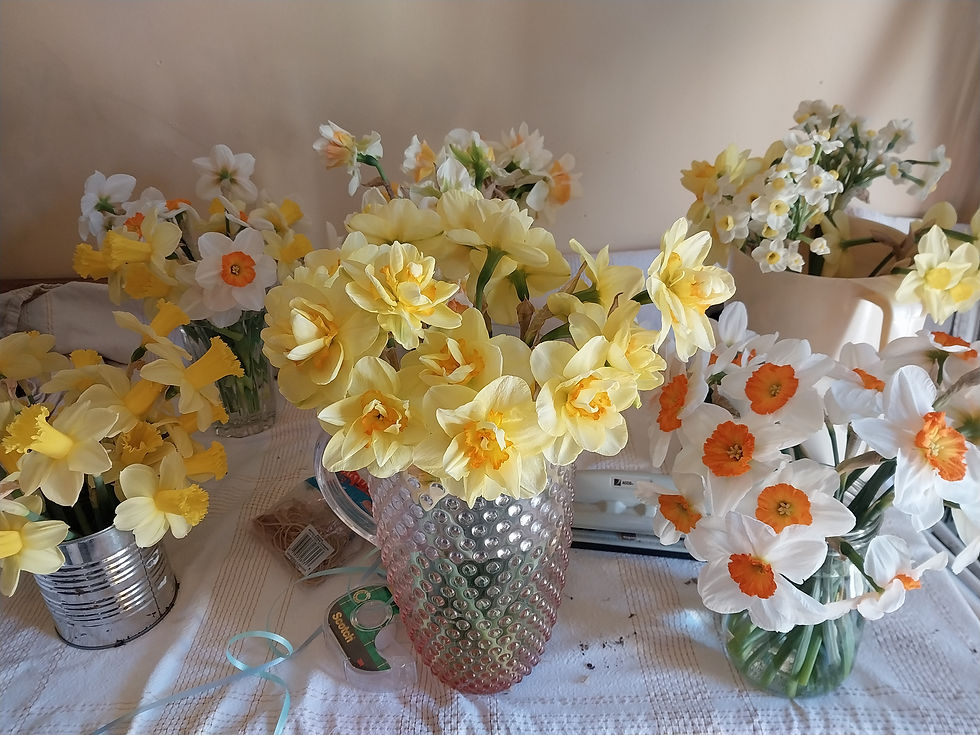Daffodil facts
- Dawn Bly

- Jan 29, 2024
- 2 min read

Q1: Are they native to Kansas?
A1: No--daffodils originate from eastern Europe and North Africa.[i] They travel well in bulb form, which is why they seem to have followed the colonial powers around the world, particularly Britain.[ii]
Q2: How many different varieties are there?
A2: Around 27,000 unique varieties.[iii] That is a lot!
Q3: What varieties do you grow?
A3: We inherited a couple of unknown varieties when we purchased our home when the Lovely Assistant was an infant. Since then, we have planted:
(Can you find them all?)
Erlicheer—A double white with multiple flowers on each stem.
Replete--A double with salmon and white.
Tahiti—A double with yellow, orange and salmon.
Bell Song—A single with salmon and yellow colors.
(It is the earliest to bloom and the last to wither!)
Professor Einstein—A single white with a red cup.
Orangey—Orange with a split cup.
Which one is your favorite?
Q4: Do rabbits and deer eat them?
A4: Rarely. Daffodil sap contains calcium oxalate and other compounds which can cause nausea, convulsions, a narcotic state and severe abdominal pain.[iv] It is occasionally fatal.
Q4: Are daffodils poisonous to humans?
A4: Yes! You should never put any part of a daffodil in your mouth! For example, in 2009, a bunch of kids in England became ill when they mistakenly added a daffodil bulb to their cookery class soup instead of an onion.[v] In addition, some people’s skin is irritated by daffodil sap (called “daffodil itch”) so just be aware and wear gloves if you think you might be reacting to your daffodils.
Which leads us, logically to the next idea:
Q5: If their sap is so irritating to humans and animals, can I include daffodils in my bouquets with other flowers?
A5: Yes, and keep these thoughts in mind: After cutting your daffodils, put them in water separate from your other flowers for several hours until the sap stops oozing from the stem. Then you can put them into your arrangements without affecting your other flowers. If you need to recut your stems, soak them separately again, too! 😊
Q6: The stem seems a bit short. How can I get a longer stem for my bouquet?
A6: Use your scissors to cut down past the soil's surface. Do not cut the leaves, just the stem. If you need a bit longer stem, try this tip: grasp the stem firmly in both hands (like you might a golf club) and pull the stem straight up. Here's a video to show you how.
Fun daffodil facts:
Ramses II was buried with a daffodil bulb on each eye.[vi] He reigned from 1279 to 1213 BC.[vii] Daffodils have been around a very long time!
Daffodils create seeds, which can be used to make new varieties of daffodils.
Enjoy your flower picking time today!

Other posts you may like:
___________________________________________________________________
[i] Daffodil, Kingsbury, Noel. Timber Press, Inc., 2013, p. 61-62.
[ii] Ibid, p. 13.
[iii] Ibid, p. 10.
[iv] Ibid, p. 19.
[v] BBC NEWS | UK | England | Suffolk | Pupils ill after bulb put in soup http://news.bbc.co.uk/2/hi/uk_news/england/suffolk/8031344.stm. Accessed 1/29/2024.
[vi] Kingsbury, Noel. p. 61.
https://www.britannica.com/question/When-did-Ramses-II-rule-Egypt, accessed 1/29/2024.
.png)




Comments